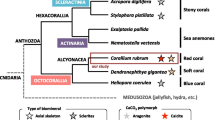Abstract
Calcification of zooxanthellate and non-zooxanthellate corals from 2 classes and 3 orders of Cnidaria was investigated using scanning and transmission electron microscopy and light microscopy. The ultrastructure of the skeleton and skeletogenic tissues (the calicoblastic ectoderm) from areas of active and non-active skeleton deposition were investigated. The results show that the fundamental cellular mechanism of calcification is similar in all 3 orders, and that the role of endosymbiotic zooxanthellae may be one that is concerned with the removal of waste products of the calcification process. The results are discussed with respect to the concepts of calcification and its evolution in the Cnidaria.
Similar content being viewed by others
References
Barnes, D. J., 1970. Coral skeletons: An explanation of their growth and structure. Science, N.Y. 170: 1305–1308.
Barnes, D. J., 1972. The structure and function of growth ridges in scleractinian coral skeletons. Proc. r. Soc., Lond. (Ser. B) 182: 331–350.
Brown, B. E., 1982. The form and function of metal containing ‘granules’ in invertebrate tissues. Biol. Rev. 57: 621–667.
Gladfelter, E. H., 1982. Skeletal development in Acropora cervicornis. I. Patterns of calcium carbonate accretion in the axial corallite. Coral Reefs 1: 45–51.
Gladfelter, E. H. & D. W. Kinzie, 1985. Metabolism, calcification and carbon production. Proc. 5th int. Coral Reef Symp. 4: 505–544.
Goreau, T. F., 1959. The physiology of skeleton formation in corals. I: a method for measuring the rate of calcium deposition by corals under different conditions. Biol. Bull. 116: 59–75.
Goreau, T. F., 1961. Problems of growth and calcium deposition in reef corals. Endeavour 20: 32–39.
Hill, D. & J. W. Wells, 1956. Cnidaria — general features. In R. C. Moore (ed.), Treatise on Invertebrate Paleontology. Part F. Coelenterata. Geol. Soc. America, Univ. Kansas Press: F5–F9.
Johnston, I. S., 1980. The ultrastructure of skeletogenesis in hermatypic corals. Int. Rev. Cytol. 67: 171–214.
Le Tissier, M. D'A. A., 1987. The nature and construction of skeletal spines in Pocillopora damicornis (Linnaeus). Ph.D. thesis, Univ. of Newcastle upon Tyne.
Oliver, J. K., 1984. Intra-colony variation in the growth of Acropora formosa: extension rates and skeletal structure of white (zooxanthellae-free) and brown-tipped branches. Coral Reefs 3: 139–147.
Pearse, V. B. & L. Muscatine, 1971. Role of symbiotic algae (zooxanthellae) in coral calcification. Biol. Bull. 141: 350–360.
Simkiss, K., 1983. Trace elements as probes of biomineralization. In P. Westbroek & E. W. de Jong (eds), Biomineralization and Biological Metal Accumulation. D. Reidel Publ. Co., Amsterdam: 363–371.
Vandermeulen, J. H., N. D. Davis & L. Muscatine, 1972. The effect of inhibitors of photosynthesis on zooxanthellae in corals and other marine invertebrates. Mar. Biol. 16: 185–191.
Author information
Authors and Affiliations
Rights and permissions
About this article
Cite this article
Le Tissier, M.D.A. The nature of the skeleton and skeletogenic tissues in the Cnidaria. Hydrobiologia 216, 397–402 (1991). https://doi.org/10.1007/BF00026492
Issue Date:
DOI: https://doi.org/10.1007/BF00026492




